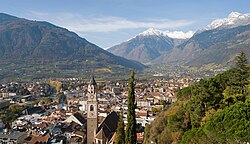Merano: Difference between revisions
historical name(s) in historical section |
Supparluca (talk | contribs) m naming conventions |
||
| Line 24: | Line 24: | ||
image_skyline=Meran 1.jpg| |
image_skyline=Meran 1.jpg| |
||
}} |
}} |
||
'''Merano |
'''Merano''' ([[German language|German]]: ''Meran''; [[Ladin language|Ladin]]: ''Maran''; Archaic (857 AD): ''Mairania''; {{lang-la|Meranum}}), is a town in the [[province of Bolzano-Bozen]], [[Italy]]. Generally best known for its [[Spa town|spa]] resorts, it is located inside a [[Depression (geology)|basin]], surrounded by mountains standing up to 3,335 m (11,000 ft), at the entrance to the [[Passeier Valley]], the [[Vinschgau|Vinschgau (Val Venosta)]] and the [[Ultental|Ultental (Val d'Ultimo)]] valleys. |
||
In the past the town has been a popular place of residence for several scientists and artists, who appreciated its mild [[climate]]. |
In the past the town has been a popular place of residence for several scientists and artists, who appreciated its mild [[climate]]. |
||
Revision as of 08:50, 15 January 2009
Merano | |
|---|---|
| Comune di Merano Stadtgemeinde Meran | |
 | |
| Coordinates: 46°40′N 11°10′E / 46.667°N 11.167°E | |
| Country | Italy |
| Region | Trentino-Alto Adige/Südtirol |
| Province | Bolzano-Bozen (BZ) |
| Frazioni | Mais (Maia), Gratsch (Quarazze), Sinich (Sinigo) |
| Government | |
| • Mayor | Günther Januth |
| Area | |
| • Total | 26 km2 (10 sq mi) |
| Elevation | 325 m (1,066 ft) |
| Population | |
| • Total | 36,539 |
| • Density | 1,400/km2 (3,600/sq mi) |
| Demonym(s) | Italian: meranesi German: Meraner |
| Time zone | UTC+1 (CET) |
| • Summer (DST) | UTC+2 (CEST) |
| Postal code | 39012 |
| Dialing code | 0473 |
| Patron saint | St Nicholas |
| Saint day | December 6 |
| Website | www.comune.merano.bz.it |
Merano (German: Meran; Ladin: Maran; Archaic (857 AD): Mairania; Latin: Meranum), is a town in the province of Bolzano-Bozen, Italy. Generally best known for its spa resorts, it is located inside a basin, surrounded by mountains standing up to 3,335 m (11,000 ft), at the entrance to the Passeier Valley, the Vinschgau (Val Venosta) and the Ultental (Val d'Ultimo) valleys. In the past the town has been a popular place of residence for several scientists and artists, who appreciated its mild climate.
History
The area has been inhabited since the 3rd millennium BC, as shown by the presence of menhirs and other findings. The story of the city proper began in 15 BC when the Romans occupied the Adige valley founding a road station, Statio Maiensis. Meran was elevated to the status of a city during the 13th century. It was capital of the County of Tyrol from 1418 to 1848.
After the county had been handed over to the Habsburg family in 1363 after the abdication of Countess Margarete Maultasch of Tyrol, in 1420 Friedrich IV moved the court to Innsbruck. Meran subsequently lost its predominant position and almost all its importance as an economic hub across the roads connecting Italy to Germany. The important mint was also moved to Hall in 1477.
The Tyrolean struggle for freedom of 1809 drew attention again to Meran. In that year, on the Küchelberg above the city, the Tyroleans eked out a victory against the French and Bavarians troops.
After World War I, Merano became part of Italy with the rest of the province of Bolzano-Bozen.

Main sights
Among the town's landmarks are the Museum of Tourism, which was opened in the spring of 2003 and shows the historical development of tourism in the province, and the Giardini di Castel Trauttmansdorff, a botanical garden. Both sites are located in the Trauttmansdorff Castle.
Also notable is the Steinerner Steg (stone bridge) across the Passirio.
Languages
According to the 2001 census, 51.50 % of the resident population speaks German as mother language, 48.01% Italian, and 0.49% Ladin.
Sports
In 1981, the World Chess Championship match between Anatoly Karpov and Victor Korchnoi was held in Merano. A chess opening, the Meran Variation of the Semi-Slav Defense, was named after the town. The first act of the musical Chess is about this world chess championship match in Merano, and features a song entitled "Merano", which includes the line, "rosy cheeked Merano, flourishing to a fault".
The city's handball team is one of the most important of Italy, winner of the scudetto in 2005. The ice hockey team won two national championships, but it is currently playing in the Second Division (A2 series).
Each September, the Gran Premio Merano takes place in the Maia Racecourse; this is the most famous Italian Steeplechase.
Tourism
Merano is a popular tourist destination especially for Germans and Italians. In summer there are concerts on the promenade almost daily, and there are fine walks around the town and in the surrounding hills, not least "Merano 2000", where there is also skiing in winter.
Food
The area is well known for its wines, both white and red, and vineyards extend right into the town. The local wine, Meranese di Collina, is a light red, best drunk young. [3]. There are also extensive orchards, and apples are exported throughout Europe. The Forst brewery on the edge of the town produces a popular range of beers, sold throughout northern Italy.
Notes and references
- ^ "Superficie di Comuni Province e Regioni italiane al 9 ottobre 2011". Italian National Institute of Statistics. Retrieved 16 March 2019.
- ^ "Popolazione Residente al 1° Gennaio 2018". Italian National Institute of Statistics. Retrieved 16 March 2019.
- ^ Hugh Johnson's Pocket Wine Book 2006




